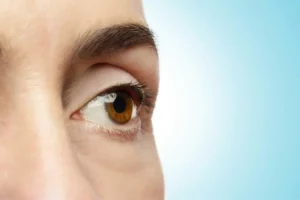Home » What are Implantable Collamer Lens
How Long Does SMILE Eye Surgery Last? – A Comprehensive Look at the ReLEx SMILE Laser Eye Surgery Procedure

Overview
Over the years, LASIK (laser-assisted in situ keratomileusis) has been the most popular and widely-performed laser vision correction procedure. However, a new, minimally-invasive procedure called SMILE (small incision lenticule extraction) has emerged as an alternative to LASIK, offering unique advantages for certain patients.
If you’re considering vision correction procedures to improve your sight, you may have come across ReLEx SMILE (Small Incision Lenticule Extraction) as an alternative to LASIK or PRK. During the LASIK procedure, an ophthalmologist creates a thin corneal flap using a femtosecond laser or a microkeratome. The excimer laser is then used to reshape the underlying corneal tissue, correcting the refractive error. The corneal flap is repositioned, and the eye heals naturally.
As a minimally invasive laser vision correction procedure, SMILE has gained popularity for its excellent outcomes and reduced recovery time. One of the most common questions asked by potential patients is, “how long does SMILE eye surgery last?” In this blog post, we’ll provide a comprehensive look at the SMILE procedure, its benefits, and its long-lasting results.
Table of Contents
What is ReLEx SMILE?
Developed by ZEISS, ReLEx SMILE is a refractive surgery that corrects refractive errors, such as nearsightedness (myopia) and astigmatism.
SMILE lasts for about 10-15 minutes.
Prior to starting the procedure, the surgical team inputs measurements tailored to your eye. After this, patients are given numbing drops to numb the eye. Anxiolytics can also be provided to put patients at ease.
The surgeon will then position you appropriately, with the help of the team, to ensure that your eye is secured accurately in line with the laser. Your eye is then cleaned to help prevent infection.
The procedure involves using a femtosecond laser (VisuMax Femtosecond Laser) to create a small, lenticule-shaped piece of corneal tissue within the cornea. The surgeon then removes the lenticule through a smaller incision (2-4mm), resulting in the reshaping of the cornea and the correction of the refractive error.

It is advised to arrange for a friend or family member to drive you back home after the procedure.
Your vision immediately after the procedure will be blurry. This will resolve gradually over the course of the next few days or weeks. Patients are often able to do most activities of daily living unaided, this includes the use of mobile devices and screens.
You will be provided with a series of eye drops prior to undergoing SMILE eye surgery which patients are advised to use as instructed, the details of which will be provided to you in your consultation with your eye surgeon.
The SMILE Procedure vs. LASIK and PRK

SMILE, LASIK, and PRK are all laser vision correction procedures, but they differ in their techniques and recovery times.
1. LASIK: In the LASIK procedure, the ophthalmologist uses a femtosecond or excimer laser to create a corneal flap, which is then lifted to allow the excimer laser to reshape the cornea’s surface. The flap is then repositioned and heals naturally.
2. PRK: PRK is a surface ablation technique in which the ophthalmologist removes the outer layer of the cornea (epithelium) and uses an excimer laser to reshape the corneal tissue beneath.
3. SMILE: As previously mentioned, the SMILE procedure does not require a corneal flap. Instead, it involves a smaller incision and the removal of a lenticule to reshape the cornea.
Advantages of SMILE Laser Eye Surgery
The SMILE procedure offers several benefits compared to LASIK and PRK:
1. Faster recovery time: SMILE patients often experience a quicker visual recovery, with most patients achieving functional vision the next day.
2. Less dry eye: The smaller incision in the SMILE procedure preserves more corneal nerves, resulting in fewer instances of dry eye compared to LASIK.
3. Better corneal biomechanics: The absence of a corneal flap in SMILE leads to a stronger and more stable cornea post-surgery.
4. Lower risk of complications: The SMILE procedure has fewer side effects and complications than LASIK and PRK, such as corneal flap-related issues and infection.
How Long Does SMILE Eye Surgery Last?
The longevity of SMILE laser eye surgery results depends on several factors, including the patient’s age, the severity of the refractive error, and the stability of the patient’s vision before surgery.
In general, SMILE surgery provides long-lasting vision correction. Studies have shown that the procedure has a high success rate, with more than 98% of patients achieving 20/40 vision or better. Most patients experience stable vision for many years following the procedure.
However, it’s essential to note that no refractive surgery can prevent the natural aging process of the eye, which may cause some vision changes over time. For instance, presbyopia (the age-related loss of near vision) may still require reading glasses for some patients,even after undergoing SMILE surgery. Additionally, certain eye conditions, such as cataracts, can develop later in life and may require further treatment like cataract surgery.
Factors That Influence SMILE Eye Surgery Results
Several factors can influence the duration of SMILE laser eye surgery results:
1. Age: Younger patients tend to have more stable vision after the procedure, while older patients may experience age-related vision changes such as presbyopia.
2. Refractive error stability: If your prescription has been stable for at least a year before the surgery, you’re more likely to enjoy long-lasting results.
3. Post-operative care: Following your ophthalmologist’s instructions for post-operative care, including using prescribed eye drops and attending follow-up appointments, can help ensure the best possible outcome and long-lasting results.
4. Severity of refractive errors: Patients with higher degrees of nearsightedness (myopia) or astigmatism may experience a slight regression over time. However, this regression is generally minimal and does not significantly impact the overall satisfaction with the procedure.

Risks and Side Effects of SMILE Eye Surgery
As with any surgical procedure, SMILE carries some risks and potential side effects. However, clinical studies have shown that SMILE is a safe and effective vision correction procedure with a low rate of complications.
Some potential side effects and risks associated with SMILE include:
1. Infection: While rare, infections can occur after SMILE surgery. Using prescribed antibiotic eye drops and following your eye doctor’s postoperative care instructions can minimize this risk.
2. Overcorrection or under correction: In some cases, the procedure may not fully correct the patient’s refractive error, necessitating additional treatment, such as enhancement surgery or wearing glasses or contact lenses.
3. Halos and glare: Some patients may experience halos or glare around lights, particularly at night, after undergoing SMILE surgery. These symptoms often improve over time as the eye heals.
4. Dry eye symptoms: Although SMILE is less likely to cause dry eye symptoms compared to LASIK, some patients may still experience temporary dryness after the procedure. Using lubricating eye drops can help alleviate these symptoms.
5. Corneal complications: Rarely, complications related to the corneal incision or lenticule removal may occur. These may include epithelial ingrowth or corneal haze.
6. Accessibility: SMILE is not suitable for all patients, such as those with thin corneas, presbyopia, or certain corneal abnormalities. A thorough evaluation by an ophthalmologist is necessary to determine if SMILE is an appropriate option.
It’s essential to discuss the potential risks and side effects with your ophthalmologist or eye surgeon before undergoing SMILE eye surgery.
Is SMILE eye surgery safer than LASIK?
Clinical studies and real-world experience suggest that SMILE laser eye surgery is a safe and effective treatment for vision problems. The procedure boasts a high success rate, with over 99% of SMILE patients achieving 20/40 vision or better, and more than 90% achieving 20/20 vision or better. Additionally, SMILE has been shown to be safer than LASIK in certain aspects, as it does not involve creating a corneal flap. This reduces the risk of flap-related issues and infections. Furthermore, SMILE also has a lower risk of corneal ectasia and reduced dry eye symptoms.
For NYC Patients
Who is a Good Candidate for SMILE Eye Surgery?
SMILE surgery is an excellent option for patients seeking a minimally invasive laser vision correction procedure. However, not everyone is a suitable candidate for the surgery. Factors that may determine if you’re a good candidate for SMILE include:
1. Age: Candidates should be at least 18 years old, with a stable prescription for a minimum of one year.
2. Refractive errors: SMILE is FDA-approved to treat nearsightedness (myopia) up to -10.00 diopters and astigmatism up to -3.00 diopters. It is not currently approved for treating farsightedness (hyperopia) or higher degrees of astigmatism.
3. Corneal thickness: Candidates should have a sufficient corneal thickness to accommodate the creation and removal of the lenticule.
4. Eye health: Good candidates should be free of eye conditions such as glaucoma, keratoconus, or severe dry eye.
Your ophthalmologist will conduct a thorough eye examination to determine if you’re a good candidate for SMILE eye surgery.
What are the risks associated with SMILE Eye surgery?
As with any surgical procedure, SMILE carries some risks and potential side effects. However, clinical studies have shown that SMILE is a safe and effective vision correction procedure with a low rate of complications.
Some potential side effects and risks associated with SMILE include:
1. Infection: While rare, infections can occur after SMILE surgery. Using prescribed antibiotic eye drops and following your eye doctor’s postoperative care instructions can minimize this risk.
2. Overcorrection or under correction: In some cases, the procedure may not fully correct the patient’s refractive error, necessitating additional treatment, such as enhancement surgery or wearing glasses or contact lenses.
3. Halos and glare: Some patients may experience halos or glare around lights, particularly at night, after undergoing SMILE surgery. These symptoms often improve over time as the eye heals.
4. Dry eye symptoms: Although SMILE is less likely to cause dry eye symptoms compared to LASIK, some patients may still experience temporary dryness after the procedure. Using lubricating eye drops can help alleviate these symptoms.
5. Corneal complications: Rarely, complications related to the corneal incision or lenticule removal may occur. These may include epithelial ingrowth or corneal haze.
6. Accessibility: SMILE is not suitable for all patients, such as those with thin corneas, presbyopia, or certain corneal abnormalities. A thorough evaluation by an ophthalmologist is necessary to determine if SMILE is an appropriate option.
It’s essential to discuss the potential risks and side effects with your ophthalmologist or eye surgeon before undergoing SMILE eye surgery.
Conclusion
ReLEx SMILE laser eye surgery is a minimally invasive, safe, and effective vision correction procedure that offers long-lasting results for many patients. The recovery time is generally shorter than that of LASIK and PRK, with fewer side effects and complications. Although no refractive surgery can prevent age-related vision changes, most patients experience stable vision for many years after the procedure.
If you’re considering SMILE eye surgery, consult with an experienced ophthalmologist to determine if you’re a good candidate and discuss any concerns or questions you may have. Understanding the procedure, its benefits, and its longevity can help you make an informed decision about your vision correction options.

IPL & RF Therapy for Dry Eyes: A Modern Solution to Long-Term Relief
Our eyes need tears to stay healthy and comfortable. If your eyes do not produce enough tears, it is

What is IPL Treatment for Dry Eyes?
What Is IPL Treatment? Photorejuvenation therapy or more commonly know as Intense Pulsed Light treatment (IPL) is a light
Intense Pulsed Light for Dry Eye
What Is IPL for Dry Eye? Intense Pulsed Light Therapy (IPL) is a quick and painless therapeutic light treatment





